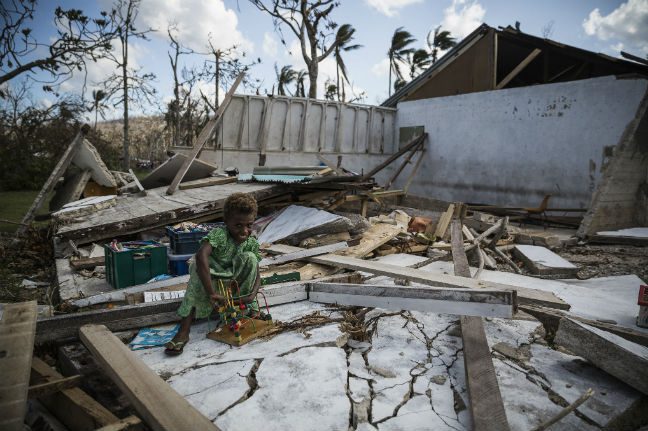
In December, the world will come together to finalise a new global climate agreement. Well before negotiators land in Paris to hammer out the details, countries must announce their provisional targets for the post-2020 period, when the new agreement will take effect.
The Australian Government has set-up a Prime Ministerial taskforce to decide on Australia’s new climate targets and its contribution to the Paris agreement. Oxfam is calling for an ambitious new commitment from Australia that aligns with our responsibilities as a rich developed country and reflects the scale of the global challenge.
What factors should the Australian Government consider in determining Australia’s climate targets?
Cyclone Pam was a forceful reminder of the consequences of climate inaction. While climate change affects us all, the impacts are being felt first and hardest among those who have contributed least to the problem, including our neighbours in the Pacific.
Climate change is threatening millions with hunger, homelessness and disease.
In other words, our starting point is a global ‘carbon budget’ – a total tolerable amount of global carbon pollution, beyond which the risks for people and planet are unacceptable.
Australia must be guided first and foremost by the science, and the scale of global action required in limiting the global temperature rise to within 1.5C, beyond which many countries have said they will face unimaginable suffering and devastation. In other words, our starting point is a global ‘carbon budget’ – a total tolerable amount of global carbon pollution, beyond which the risks for people and planet are unacceptable.
The task is then to work out Australia’s fair share of this remaining global carbon budget and how much we need to cut our emissions in order to keep to it. Here we need to consider a number of factors.
The UN Framework Convention on Climate Change requires countries to act in accordance with their responsibility for the problem and their capacity to help fix it. So Australia’s very high per-capita emissions and cumulative contribution to climate change over time are one important factor, along with our relative wealth and our capacity for action. The Convention also recognises that countries are at different levels of development.
In other words, it is unreasonable to expect a poorer country’s emissions to peak and decline as rapidly as a wealthy developed country like Australia’s.
So what should Australia’s targets be?
Well, we’ve done the math. Australia should aim to reduce its own emissions by at least 40% below 2000 levels by 2025 and at least 60% by 2030. We must achieve net zero emissions as soon as possible and well before mid century.
This includes having a concrete plan to phase-out coal from Australia’s energy supply.
But importantly, this is just one part of our contribution to global climate action. As a developed country, we must also provide substantial assistance to developing countries in tackling climate change – both adapting to those impacts that can no longer be avoided and implementing their own low-carbon development strategies, in particular renewable energy and reducing dependence on fossil fuels.
This is known as ‘climate finance’. The first step for Australia is to develop a strategy for scaling up our current contribution to reach a fair share of the existing international goal to provide $100bn of climate finance a year by 2020.
Can Australia achieve these targets? What will it take to get us there?
In working out their ‘fair share’ of emissions cuts, countries can have some regard for their particular ‘national circumstances’. Some countries will find it easier to cut their carbon pollution than others.
While Australia currently relies heavily on coal for its energy, we are blessed with some of the world’s best potential for renewable energy. Australia has everything it needs to lead the world on climate action and transition rapidly to a carbon neutral and renewable energy-based economy, except political will and the right policies. Among other measures, Oxfam believes Australia must have an effective price on carbon and ambitious Renewable Energy Target.
It’s time to stop subsidising polluting industries and begin building the zero carbon economy of the future.
Conclusion
The world is acting on climate change. Not fast enough, but momentum is building, and right now Australia risks being left for dust. Developed and developing countries alike are coming forward with progressively more ambitious commitments. The global call for climate action is growing louder the closer we get to Paris.
Around the world people and businesses are demanding strong action from their governments, and more countries are recognising they have an overwhelming national interest in seeing a strong and effective global climate agreement.
It’s time for Australia to be a responsible global citizen, listen to the those bearing the brunt of climate change, and come forward with an ambitious new commitment to global action.
Ask the Australian Government to take urgent climate action now.
